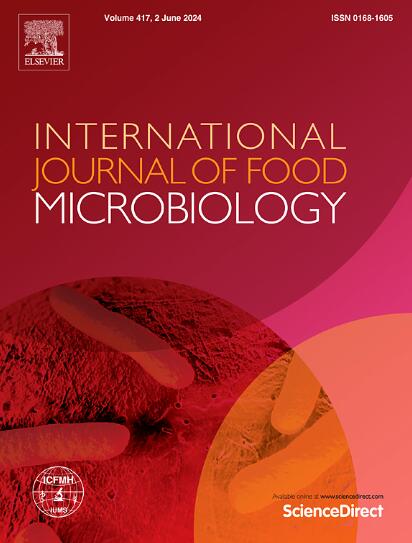阪崎克罗诺杆菌在全球范围内从食品系统到消费者的基因组多样性
IF 5
1区 农林科学
Q1 FOOD SCIENCE & TECHNOLOGY
International journal of food microbiology
Pub Date : 2025-06-30
DOI:10.1016/j.ijfoodmicro.2025.111335
引用次数: 0
摘要
了解食源性病原体如何适应不断变化的环境对于改进食品安全监测和控制至关重要。阪崎克罗诺杆菌是一种与婴儿配方奶粉暴发有关的持续性机会性病原体,对新生儿和其他脆弱人群构成严重的健康风险。这项研究验证了阪崎弧菌的遗传变异与全球食物系统中特定的分离来源和地理起源相关的假设。我们对来自北美、亚洲和欧洲的食物、环境和临床来源的阪崎肠杆菌进行了全基因组学荟萃分析。为了实现隔离元数据描述符分类的标准化,提出了一种鲁棒微调生成预训练转换(GPT)模型。利用748个坂崎木(C. sakazakii)基因组片段构建和注释了其泛基因组,发现基因组大小和附属基因谱与来源类型和起源大陆显著相关。与来自替代食品的分离物相比,来自粉状食品的分离物具有更大的基因组,并且在DNA复制、重组和修复(例如转座酶、整合酶)等功能上丰富,这些功能被标注为同源基因簇(COG) L类。采用辅助基因和毒力因子同源亚群的随机森林模型能够准确预测源归因,将VI型分泌系统和重金属反应基因确定为分离源的关键指标。与外排相关的几种抗菌素耐药基因(即arlR、facT、oprZ)也表现出生物地理模式。总体而言,本研究揭示了阪崎弧菌在整个食物系统中的关键辅助遗传元件分布,揭示了其持久性和传播的假定适应性。我们的可重复和自动化工作流程在新兴食品安全问题的分子监测中具有潜在的应用。本文章由计算机程序翻译,如有差异,请以英文原文为准。

Genomic diversity of Cronobacter sakazakii across the food system to consumers at the global scale
Understanding how foodborne pathogens adapt to changing environments is essential for improving food safety monitoring and control. Cronobacter sakazakii, a persistent opportunistic pathogen associated with powdered infant formula outbreaks, poses critical health risks to neonates and other vulnerable populations. This study tested the hypothesis that genetic variation in C. sakazakii correlates with specific isolation sources and geographic origins across the global food system. We conducted a pangenomics meta-analysis of C. sakazakii derived from food, environmental, and clinical sources spanning North America, Asia, and Europe. A robust fine-tuned Generative Pre-trained Transformer (GPT) model was developed to standardize the categorization of isolate metadata descriptors. C. sakazakii genome assemblies (n = 748) were used to build and annotate the pangenome, and genome size and accessory gene profiles were found to be significantly associated with source type and continent of origin. Isolates from powdered foods, compared to those sourced from alternative foods, had larger genomes and were enriched in functions annotated to Clusters of Orthologous Genes (COG) category L for DNA replication, recombination and repair (e.g., transposase, integrase), among other features. Random forest models using both accessory genes and the subset of virulence factor homologs accurately predicted source attributions, identifying type VI secretion system and heavy metal response genes as key indicators of isolate origins. Several antimicrobial resistance genes associated with efflux (i.e., arlR, facT, oprZ) also exhibited patterns for biogeography. Overall, this study uncovered the distribution of key accessory genetic elements of C. sakazakii throughout the food system, revealing putative adaptations for its persistence and transmission. Our reproducible and automated workflow has potential applications in molecular surveillance for emerging food safety concerns.
求助全文
通过发布文献求助,成功后即可免费获取论文全文。
去求助
来源期刊
CiteScore
10.40
自引率
5.60%
发文量
322
审稿时长
65 days
期刊介绍:
The International Journal of Food Microbiology publishes papers dealing with all aspects of food microbiology. Articles must present information that is novel, has high impact and interest, and is of high scientific quality. They should provide scientific or technological advancement in the specific field of interest of the journal and enhance its strong international reputation. Preliminary or confirmatory results as well as contributions not strictly related to food microbiology will not be considered for publication.

 求助内容:
求助内容: 应助结果提醒方式:
应助结果提醒方式:


